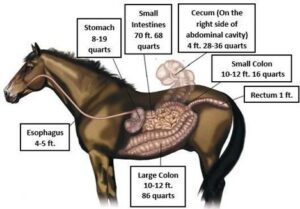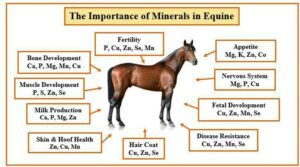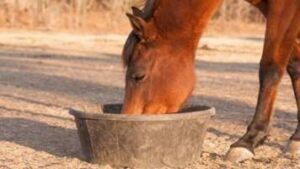Horses are not ruminants, but still can live off of plant material. Horses are grazing animals with digestive tracts best suited for eating forages for 15- 20 hours per day. Grass and hay are the natural feeds for horses due to the structure and shape of the equine digestive tract. Unlike the cow, their stomachs are relatively small and can only hold about eight quarts. Their stomachs can actually hold more, but the stomach begins to empty when it is only two-thirds full. After the feed passes through the stomach it goes through the small intestines, where most of the starch, sugar, fat, vitamins and minerals and about half the protein from the feed should be digested and absorbed into the bloodstream. The remaining nutrients and the plant fibers continue on to the hindgut. The hindgut of the horse has huge fermentation vats that can hold 85-115 liters of fibrous material while billions of bacteria and other organisms work to digest it. Fiber-digesting bacteria produce volatile fatty acids (VFA) that are used by bacteria and horses for energy. Horses on total forage diets receive 70% of their energy from these VFAs.
Some of the remaining proteins and some of the minerals, especially phosphorus, are absorbed in the large intestines, along with water, which is recycled within the body. Bacteria in a healthy horse’s hindgut also produces B-vitamins that can be used by the horse. The equine digestive system is very efficient if horses are fed mainly grass or hay. Grain is where things get tricky. If horses are fed too much grain in meals, their system will not work very well. The high starch content in grain is difficult to digest. The horse’s small intestines don’t have enough enzymes to break it down. When starch enters the hindgut the starch–digesting bacteria uses starch to produce lactic acid. The addition of lactic acid in the hindgut results in lowering the pH. Many beneficial, fiber–digesting bacteria cannot handle the more acidic conditions resulting in them dying and releasing toxins in the hindgut. The presence of these toxins results in colic and founder. Feeding 2.5 kg or less grain-based feeds daily greatly reduces the risk of colic and founder. Horse forages should provide as much as possible of energy, protein and fiber. If the forages don’t have enough to meet the horse’s requirements that is when grain should be added to the diet, but only small amounts. If forages are of good quality then they should be receiving proper amounts of minerals in their diet, besides sodium chloride (salt). Minerals are required for the maintenance of many body functions and structures all listed in the picture on the next page. If their forages are poor then minerals and vitamins should be supplemented in the ration for a balanced diet.
Product of the Week: MBA Equine Mineral
MBA Equine Mineral is a complete, balanced mineral supplement for horses. It can be used as a free-choice mineral or fed as a grain supplement.
Product Characteristics:
- Provide calcium and phosphorus from highly available
- Contains multiple sources of magnesium to maintain muscle and nerve
- Includes yeast culture, salt and specialized flavorings for palatability.
- Contains sulfate forms of trace
- Contains Redmond Natural Trace Minerals
- Provides selenium from selenium
- Includes Thorvin Icelandic kelp as a source of over 60 trace minerals and vitamins to help improve reproductive health, immune system function and hoof
- Produced in an ionophore-free facility for
Horse Nutrition Facts
- Horses can only chew on one side of their mouth at a time.
- They chew with an outside-to-inside motion on a slant.
- The horse can produce up to ten gallons of saliva per day if allowed to eat plenty of forage.
- Saliva helps neutralize stomach acids, therefore reducing the risk of gastric ulcers.
- The horse’s esophagus only works in one direction.
- Food can go down, but cannot come back up, therefore horses cannot vomit.
- Food only remains in the horse’s stomach for around 15 minutes.
- When the stomach is empty, acid can attack the squamous cells in the stomach lining.
- This often results in ulcers and is why small frequent meals, access to a slow feed hay net, free-choice hay, or access to pasture are very important.
- The majority of the digestion occurs in the horse’s small intestine.
- This is where sugars, starches, proteins, and fats are absorbed.
- When the stomach is empty, acid can attack the squamous cells in the stomach
- This often results in ulcers and is why small frequent meals, access to a slow feed hay net, free-choice hay, or access to pasture are very important.
- Horses do not have a gall bladder.
- Food can only enter and exit the cecum (also known as the ‘blind gut’) from the top.
- If a horse doesn’t have adequate water intake, this can be a common site for impaction colic.
- The cecum and other parts of the large intestine contain active populations of bacteria and other microbes.
- These bacteria and microbes help break food down in a process called fermentation.
- The bacterial and microbe populations become specific in fermenting the type of food the horse normally eats.
- Lignin, a type of dietary fiber abundant in overly mature hay, cannot be broken down by fermentation.
- Therefore, it is passed in the feces.
- Gut sounds (borborygmus) are a sign that food is moving through the digestive tract.
- The absence of gut sounds can mean there is a blockage.
- A horse requires a minimum of 1% of his body weight daily of long-stemmed roughage (grass, hay, or hay replacers) for normal digestive tract activity.
- This would amount to ten pounds of roughage for a 100-pound horse.
- On average, the entire digestive process for the horse takes anywhere from 36-72 hours.
- A horse’s digestive tract would measure about 100 feet in length if it were to be stretched from end to end.
- Most of this is intestines.




